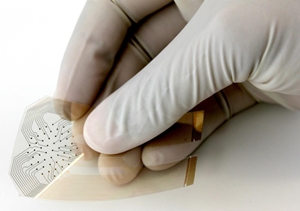18 March 2015. A device with tiny electronic sensors in a flexible bandage is able to detect the earliest stages of tissue damage leading to pressure ulcers or bedsores, in tests with lab animals. The findings of research engineers from University of California in Berkeley and clinicians from University of California in San Francisco appear in yesterday’s issue of the journal Nature Communications (paid subscription required).
The team led by Berkeley engineering professor Michel Maharbiz sought a way of detecting changes in skin and underlying tissue before they become visible damage and then open sores. Bedsores result from prolonged pressure on skin, particularly in bony areas such as hips, tailbone, and heels. People confined to beds or wheelchairs due to medical condition, especially in hospitals or nursing homes, are most at risk.
In 2011, Centers for Disease Control and Prevention estimated bedsores affect 2.5 million people each year. And a 2012 study says people who develop bedsores are almost 3 times as likely to die in a hospital than those who do not.
Maharbiz and colleagues adopted a technique called impedance spectroscopy that gauges organic changes in skin cell health by measuring changes in electrical current. Healthy cell walls act like an insulator, and as skin cell walls start to break down from the continuous pressure, more electric current leaks through, and detected by the device.
The bandage has dozens of electrodes implanted in a flexible strip worn on the skin over areas most likely to form bedsores. With the sensor-bandage, impedance spectroscopy maps changes in tissue structure reported by the electrodes that could lead to bedsores by identifying where variations in electrical current are occurring.
The Berkeley-San Francisco team simulated bedsores in lab rats, by squeezing their bare skin between magnets for 1 to 3 hours. After removing the magnets, inflammation and oxidative stress occurred in the skin, with mild and reversible damage evident after 1 hour and greater — even permanent — damage occurring after the magnets remained in place for 3 hours. The researchers applied sensor-bandages to the damaged skin once a day for 3 days, and found the impedance measurements correlated strongly with the health of the tissue.
Maharbiz believes the smart-bandage technology can be applied to more disorders than bedsores. “As technology gets more and more miniaturized” says Maharbiz in a UC-Berkeley statement, “and as we learn more and more about the responses the body has to disease and injury, we’re able to build bandages that are very intelligent.” Co-author David Young, professor of surgery at UC-San Francisco, is leading a clinical trial of the technology.
Mharbiz tells more about the sensor-bandage in the following video.
- Pen-Dispensed Bio-Inks Developed for On-Demand Sensors
- Brain Sensor Designed for Wireless Connections
- Paper-Based Synthetic Bio Sensors, Circuits Developed
- Graphene Sensor Designed for Wearable Disease Detection
- Challenge Seeks Development Partner for Nanotech Biosensor
* * *


 RSS - Posts
RSS - Posts
[…] Sensor-Bandage Device Detects Early Forming Bedsores […]